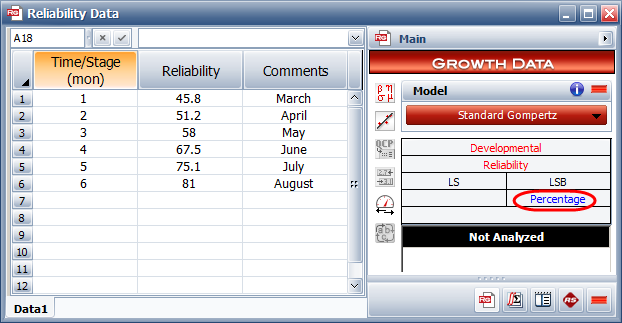

The Reliability data type is used for modeling the relationship between time and reliability. You can use the Standard Gompertz, Modified Gompertz, Lloyd-Lipow or Logistic models to track how the reliability changes over time.
The Reliability column is for recording the reliability values. The reliability can be computed by dividing the number of systems still operating by the total number of systems, or by performing life data analysis (e.g., Weibull analysis) or other related methods. The Time/Stage column is for recording the cumulative test "time" when the reliability was computed. This can be measured in terms of test stages, design configurations, development time, and the like.
In this data sheet, reliability values are entered as decimals; however, you can configure the data sheet to accept percent values. You can change the setting by selecting or clearing the Use percents (not decimals) for reliability check box on the Calculation page of the Application Setup.
In the following example, the "Numerical" label on the control panel indicates that the reliability values are decimal values.

The next example shows the "Percentage" label on the control panel and the same data set as above, but entered as percent values.

By default, all data sheets include a Comments column for logging any pertinent information about each row of data. You can add a second comments column or delete the columns by choosing Growth Data > Format & View > [Insert Columns/Delete Columns] > Comments. The information in these columns does not affect the calculations in the folio.
See also Minimum Data Requirements for Reliability Data.
© 1992-2019. HBM Prenscia Inc. ALL RIGHTS RESERVED.
| E-mail Link |